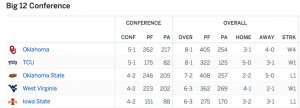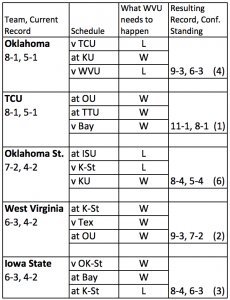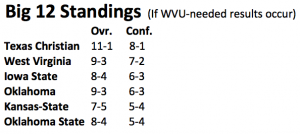Even though it left you with a nasty, sour taste in your mouth, the 2017 regular season was a success for West Virginia.
Sure, the year consisted of a combined -39 score differential to teams from the state of Oklahoma, and won’t end in as exciting of a bowl game as Mountaineer fans would’ve liked, but yes, it was a success.
Not just because finishing at 7-5 clinches another winning season, the 49th such year since the conclusion of WWII, but because of a number of reasons. Five to be exact.
- Grier lived up to the hype
Think back to before the season even started. The hype was massive. Fans were thinking, or hoping, that Will Grier would singlehandedly take the Mountaineers to the promised land.
Or at least that’s what they were saying.
He didn’t do that, but Grier put together one of the best seasons for a quarterback in West Virginia history.
Grier’s 34 touchdown passes are the second most, and his nearly 3,500 passing yards are the fourth most in a single season.
He was also confident and poised in the pocket, confident in his throws, and completed a good number of his passes (64.4 completion percentage).
Then the injury happened that derailed Grier’s, and by association the team’s, hopes at playing in a big bowl or even the Big 12 title game.
- A good 7-3 team before the injury
West Virginia wasn’t a complete team before Grier’s injury. This team has a number of holes or areas of improvement, but that doesn’t mean the Mountaineers were a bad team by any means.
Think back to the first game of the year when WVU — with a new offensive coordinator, new quarterback, short-handed receiving corps, and a defense wasn’t 100-percent — went toe-to-toe against an established Virginia Tech team, albeit coming up just short. With those factors, that was a good sign for what was to come.
A seven-point loss to TCU highlighted a lot of those areas that needed improving, and for at least one unit was a pivotal turning point that will be highlighted a little later.
A comeback win over a then-ranked Texas Tech team, not falling victim to the hype that Iowa State had when it came to Morgantown, and not allowing the wheels to fall off and give Baylor a victory were big when they occurred.
Individually, the Mountaineers were – and still are – on pace to have a trio of 1,000-yard wide receivers and a 1,000-yard rusher. The Mountaineers would be the first team since Tulsa in 2007 to complete the task.
- Major improvements on special teams
The aforementioned loss to TCU confirmed that special teams can make all the difference in a close game.
After forcing the Horned Frogs to punt, a fumble forced by the Mountaineer return unit gave the ball right back to TCU, and turned into seven points. West Virginia went on to lose by seven.
Special teams hadn’t played great up to that point of the year.
Punter Billy Kinney wasn’t performing as well as the coaches would’ve liked, the Mountaineers weren’t getting much from their return units, and coverage was allowing opposing return units to dictate the field position battle at times.
The TCU loss put an emphasis on special teams.
The unit greatly improved from that game on, consistently earning good grades in the weekly report card, and maybe just as importantly, weren’t being mentioned post-game as reasons for a loss when one occurred.
Credit these improvements to the change made over the offseason involving head coach Dana Holgorsen, who said one of the reasons he wanted to give up the offensive play calling duties to give more attention to special teams.
- No more Manhattan monkey
Entering the season there were only two places in the Big 12 that West Virginia had been unable to secure a victory in since joining the conference – Manhattan, Kansas, and Norman, Oklahoma.
One of those places was scratched off the list.
Two weeks ago, WVU marched into a rainy Bill Snyder Family Stadium and walked out with a 28-23 win; holding off the Wildcats late, something that has been troublesome in the past.
A year ago, West Virginia’s win over Kansas State was big because it proved that Holgorsen could beat the man he’s looked up to for so long.
This year, the win over Snyder and K-State, in the building that dons the head coach’s very name, proved that Holgorsen’s teams can walk into almost anywhere and feel they have a shot. That’s an added bonus moving forward that shouldn’t be overlooked.
- Good foundation laid for next year
Looking ahead to 2018, there will be some losses from this year’s squad. Twenty seniors include both White brothers, Ka’Raun and Kyzir, and Justin Crawford.
That’s over 2,000 yards of offense and 81 tackles no longer suiting up.
Other losses obviously include seniors such as Al-Rasheed Benton, Elijah Wellman, Kyle Bosch and multiple players in the secondary.
Despite those losses, a good foundation has been laid for the coming seasons.
David Long Jr. is a stud and has proved it every game since returning from injury.
Kennedy McKoy and Martell Pettaway will be a formidable backfield for Grier, who will likely still have a receiving corps that includes David Sills V, Gary Jennings, and Marcus Simms.
Young players such as Kenny Robinson (S/Fr), Dylan Tonkery (LB/r-Fr), Hakeem Bailey (CB/r-So), Reese Donahue (DL/So), and Lamonte McDougle (DL/Fr), among others, show that the defense should only get better from here.
Another winter, spring, and summer to get even more familiar with the offense, and it’s not out of the question to hope for even better numbers out of Grier and the offense next year.
The regular season may not have ended on the most positive of notes, with a pair of loses and a major injury.
Regardless, this regular season was a success for West Virginia. A win in the soon-to-be-determined bowl game would give the Mountaineers eight wins in a season for the fourth time during Holgorsen’s tenure, and 13th time since 2000.
Less than 12 months after last season’s Mountaineers won 10 games in the regular season, a seven-win campaign doesn’t feel quite as good, but it was successful nonetheless.




